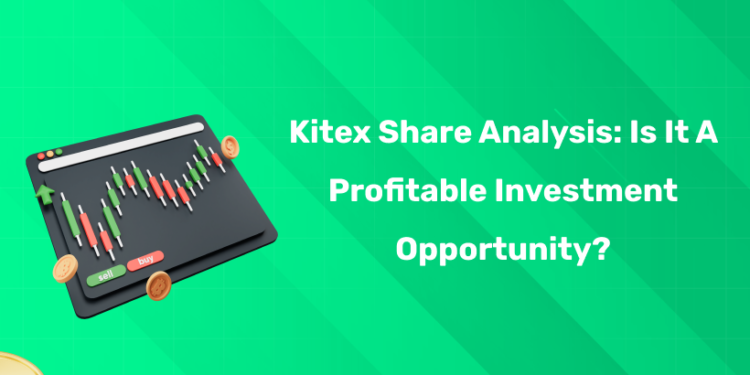Table of Contents
Introduction
In this Kitex Share Analysis, we check various aspects regarding whether it makes sense to invest in Kitex Garments Ltd (stock symbol: KITEX) in today’s market. With a strong presence in infant-wear exports, the firm has drawn investor attention. This article aims to dig deeper into its origin, operations, financials, competitive landscape and future prospects to decide: is this a profitable investment opportunity?
History of the Company
1: What is a stock?
- Incorporated in 1992, Kitex Garments Ltd began as part of the Anna Kitex Group.
- It focuses on exports of cotton and organic-cotton garments (infant & kids wear) to the US and Europe.
- Hailing from the state of Kerala in India, the group has its headquarters in Kochi / Aluva region.
- Over a period of time, Kitex has scaled operations, expanded capacity, and positioned itself competitively in the infant‐wear export segment.
Learn Stock Marketing with a Share Trading Expert! Explore Here!
Business Model
- Manufacture of knitted fabrics and ready-made garments (infants’ suits, sleepwear, training pants, bibs, etc).
- Focus on exports to global markets (US, Europe) with emphasis on cotton & organic-cotton product lines.
- Scale production leveraged by a large manufacturing base to achieve cost efficiencies and meet large buyers’ needs.
- Revenue generation via bulk orders, long‐term relationships with global retailers, and specialization in the niche infant apparel segment.
- Reinvestment in capacity expansion, infrastructure, and maintaining compliance/supply-chain standards for export markets.
Leadership, Branding and Trust
- Led by Sabu M. Jacob, Managing Director, who has steered the company’s growth in exports and consolidation.
- Strong brand recall in the infant‐wear export business, with the company being the world’s second-largest manufacturer in its segment (as per some reports).
- Commitment to quality, organic cotton offerings & export compliance builds trust with international buyers.
- Being part of a well-known group from Kerala adds regional brand strength and local manufacturing advantages.
- Transparent financial disclosures and listings (on NSE/BSE) help build investor trust.
Milestones & Achievements
- Hit a revenue of around INR 983 crore in FY 2025 (approx) showing strong year-on-year growth.
- Operating profit almost doubled in FY 2025 compared to previous year (₹201 crore) from ₹101 crore.
- Global recognition in the infant-wear manufacturing segment, gaining export scale and international buyer base.
- Expanded manufacturing footprint and working capital efficiency improvements in recent years.
- Began commercial production at its manufacturing unit in Warangal, Telangana which has a capacity to produce 1.1 million pieces of ready-made children’s wear a day.
- Launched US babywear brand ‘Little Star’ in the Indian market
Stock Market Training Reviewed & Monitored by SEBI Registered RA
Trusted, concepts to help you grow with confidence. Enroll now and learn to start investing the right way.
Know moreCompetitors
Key peers and rivals of Kitex Garments within the textile/apparel space include:
- Page Industries Ltd – strong in innerwear and branded apparel
- KPR Mill Ltd – integrated textile chain operations
- Vedant Fashions Ltd – apparel and fashion retail business
These companies operate in overlapping segments; hence the comparison helps in the “Kitex Share Analysis”.
Kitex’s Share Price, Market Capitalisation & Related Details
| Metric | Value |
| Share Price (approx, Oct 24 2025) | ₹222.11 |
| 52-Week Range | ₹147.01 (Low) – ₹324.42 (High) |
| Market Capitalisation | ₹4,431 crore (₹44.31 billion) |
| Price/Earnings (P/E) Ratio | 33.5x (as per some sources) |
| Price/Book (P/B) Ratio | 4.3x |
This table summarises the key market metrics for our Kitex Share Analysis.
Financial Performance Overview
In our deeper Kitex Share Analysis, the financials show:
- For FY 2025 (ending March): Revenue ₹983 crore, Net Profit ₹136 crore.
- Operating profit rose 99.7% YoY to ₹201 crore.
- PAT margin 13.8% in FY 2025, up from 9.05% in FY 2024.
- EPS declined to ₹6.80, though revenue growth was strong.
- Debt to equity ratio 1.05x in FY 2025 (from lower levels earlier) – indicating increased leverage.
- Recent quarterly numbers (June 2025): Revenue ₹201 crore, Net Profit ₹26 crore.
- Total revenue for the financial year ended March 31st stood at ₹1,001 crore, against ₹631 crore in the previous year.
- For the full year, Kitex posted a net profit of ₹135.7 crore, an increase of 141% over the previous year.
The above numbers suggest solid growth in recent years, but also some emerging concerns (like EPS drop, higher leverage) which must feed into the decision in our Kitex Share Analysis.
Peer Comparison
| Company | P/E | P/B | ROE / ROCE (approx) |
| Kitex Garments Ltd | 33.5x | 4.3x | ROE 14% (FY 2025) |
| Page Industries Ltd | Lower P/E (industry benchmark) | Lower P/B | Higher ROE and brand strength |
| KPR Mill Ltd | mid-P/E | mid-P/B | Manufacturing integrated textile player |
In this Kitex Share Analysis, the company appears to carry a higher valuation multiple compared to some peers. The brand strength and export niche partially justify the premium, but investors must weigh whether the growth justifies the current valuation.
Challenges and Risk Management
For our Kitex Share Analysis, key risks include:
- Valuation risk: With high P/E and P/B ratios, expectations are baked in. Any slowdown could hurt sentiment.
- Raw material cost volatility: Cotton and organic cotton inputs carry price risks, which can compress margins.
- Export dependence: The majority of businesses have a dependence on foreign markets; currency fluctuations, trade policies or global demand shifts pose risks.
- Working capital & leverage: Rising debt (D/E 1.05) suggests increased reliance on borrowing. If growth slows, interest burden may adversely affect.
- Competition and margin pressure: With peers and emerging manufacturers in low‐cost geographies, sustaining differentiated value is challenging.
- Operational risk: Large manufacturing scale means any disruption (labour, logistics, compliance) could impact supply.
To mitigate, Kitex should keep improving efficiency, diversifying markets, hedging currency exposure, and maintain prudent leverage.
Future Outlook
From the vantage of our Kitex Share Analysis:
- The company’s niche in infant-wear export is a positive structural tailwind: global demand for children’s wear remains stable and growing.
- Its recent strong revenue growth suggests that the business is gaining momentum—if sustained, earnings could catch up.
- With margin improvement and scale, ROE / ROCE may rise, bridging the gap with valuation.
- If the company reduces debt, enhances cost controls and expands into adjacent segments (maybe further downstream in apparel), upside potential exists.
- On the flip side, if growth slows or margin slips, the current valuation offers little cushion. Investment would more likely be speculative than safe.
Thus, the future outlook is cautiously optimistic: there is upside, but also non-trivial risk—so the question of “profitable investment opportunity” depends heavily on growth execution and market conditions.
Key Takeaways
- Our Kitex Share Analysis shows Kitex Garments has a strong export‐oriented business model, niche brand in infant wear, and recent uptick in financial performance.
- The valuation is relatively elevated compared with peers; this means expectations are high and execution must deliver.
- Financial health shows improvement but some caution flags (leverage, EPS decline) are present.
- Competitive and macro risks exist (raw materials, exports, global demand).
- A long‐term investor confident in the company’s expansion, margin improvement and global demand growth might view it as a worthwhile opportunity. However, a risk‐averse investor might wait for a better entry or stronger margin assurances.
Learn Stock Marketing with a Share Trading Expert! Explore Here!
Parting Words
Interested in learning more about stock market trading and investing? There is no better option than Entri Finacademy, a SEBI-compliant finance education platform with over 9 million students across India. The highlight of this platform is that for beginners, it offers stock market training right from the scratch to the advanced levels. To add on, Entri provides courses in 5 regional languages, including Malayalam. With amazing features such as interactive online classes and exclusive doubt clearance sessions, Entri is undoubtedly the best platform to choose from.
Now, what are you waiting for? To join Entri Finacademy’s courses right away, click here.
Stock Market Training Reviewed & Monitored by SEBI Registered RA
Trusted, concepts to help you grow with confidence. Enroll now and learn to start investing the right way.
Know moreFrequently Asked Questions
What does the term “Kitex Share Analysis” cover?
It refers to the detailed evaluation of Kitex Garments’ business, financials, valuation, risks and prospects to help decide if investing in its shares makes sense.
Is Kitex a good option for investing in the long-term?
Potentially yes, provided the company sustains strong growth, improves margins and manages risks. However, it is not without caution as its valuation is elevated and there are some risk factors.
What valuation metrics are important for Kitex?
Key metrics include P/E ratio, P/B ratio, ROE/ROCE, debt‐to‐equity, margin trends, revenue growth.
How concentrated is Kitex’s export business?
The company has a heavy focus on export markets (US/Europe) for infant-wear, due to which currency and global demand risks are meaningful.
Which are the main competitor companies of Kitex?
Some of the competitors include apparel/textile companies like Page Industries, KPR Mill, Vedant Fashions; each has different business models but operate in adjacent segments.
What are the major risks for Kitex going forward?
Risks include raw material price volatility, export market slowdown, competition, margin compression, high valuation and increased leverage.
At what price can Kitex be considered to be undervalued?
It depends on assumptions about growth and margin improvement. If the company can significantly boost ROE/ROCE and deliver higher compounding growth, the current valuation might be justified; otherwise a more conservative valuation would mean waiting for a lower price or stronger fundamentals.














